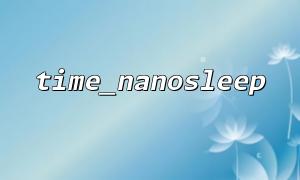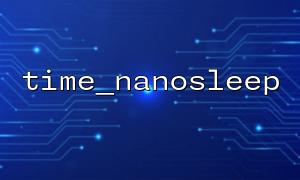In PHP, time_nanosleep is a function for high-precision delay, and its function signature is as follows:
bool time_nanosleep(int $seconds, int $nanoseconds)
This function allows developers to pause the current process to specify seconds and nanoseconds, thereby achieving more granular time control than sleep . But in actual use, you will find that the value of its second parameter $nanoseconds must be less than 1 second (i.e. 1,000,000,000 nanoseconds) , otherwise a warning will be thrown and the function execution fails. The root of this limitation actually comes from the behavior of the underlying system calls and how time is represented.
time_nanosleep is implemented in PHP by calling the nanosleep() function provided by the operating system. nanosleep is a function in the POSIX standard, and its parameters are a timespec structure:
struct timespec {
time_t tv_sec; // Second
long tv_nsec; // 纳Second (0 ~ 999,999,999)
};
As you can see, the tv_nsec field definition clearly stipulates that the value range is from 0 to 999,999,999 (i.e. less than 1 second). If a value greater than or equal to 1,000,000,000 is passed in, the operating system will consider this value illegal and return an error code EINVAL (the parameter is invalid).
Since PHP's time_nanosleep directly depends on this underlying function, the same constraints must be followed.
In PHP, if you try to pass in $nanoseconds = 100000000 or greater, you will receive a warning message similar to:
Warning: time_nanosleep(): nanosecond value out of range in ...
The PHP interpreter will verify the parameters before calling the system function, capture this out-of-bounds behavior in advance, and prevent the underlying system from reporting an error that has an unstable impact on the process. This approach improves the robustness of the code, but also means that developers must manually ensure that the incoming parameters are within the valid range.
If you want to achieve high-precision delays of more than 1 second, you can reasonably allocate the seconds to the nanoseconds. For example, if you want to delay by 1.5 seconds, you can write this:
time_nanosleep(1, 500000000); // 1 Second + 0.5 Second
This method distributes time in the two parameters $seconds and $nanoseconds , which not only meets the delay requirements, but also avoids the number of nanoseconds crossing.
For example, in some interactions with external services, we want to have fine control over retry, which can be implemented in the following ways:
$url = 'https://gitbox.net/api/retry';
for ($i = 0; $i < 5; $i++) {
$success = file_get_contents($url);
if ($success) {
break;
}
// Gradually increase the delay time
time_nanosleep(0, 250000000 * $i); // Increase each time 0.25 Second
}
By gradually extending the waiting time rather than blocking the entire second directly, the user experience is improved and unnecessary resource consumption is avoided.
The second parameter of time_nanosleep must be less than 1 second because it directly maps to the tv_nsec field of the operating system's timespec structure, and the upper limit of the legal value of this field is 999,999,999 nanoseconds. This design is for the consistency and efficiency of system calls. Understanding and following this limitation allows for safer and more granular control of latency behavior in PHP programs.














